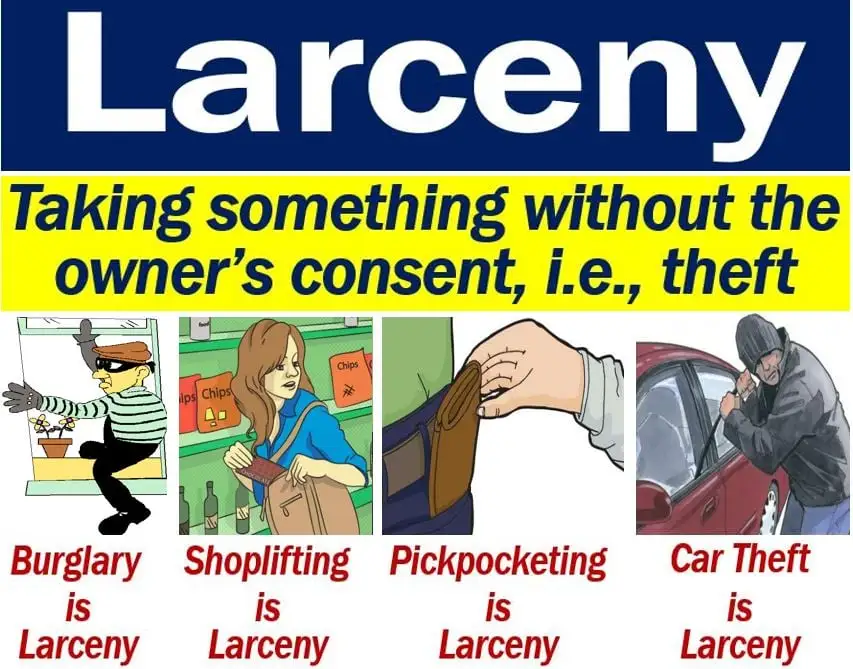What is Larceny? term often heard in discussions of crime, but its precise meaning and implications can sometimes be unclear. In simple terms, its refers to the unlawful taking of someone else’s property with the intent to permanently deprive them of it. This definition encapsulates not only the act itself but also the intention behind it, distinguishing this from other forms of theft and property crime. In this article, we will delve deeper into the concept of larceny, its types, legal definitions, consequences, and the broader implications within the criminal justice system.
If you want some more information about what is a Bodega then checkout our last blog post.

The Definition of Larceny
This crime is traditionally defined in legal terms as the unlawful taking and carrying away of someone else’s personal property with the intent to permanently deprive the owner of that property. To establish larceny, three key elements must typically be proven:
- Taking: The act of taking possession of someone else’s property.
- Carrying Away: The property must be moved, however briefly.
- Intent to Permanently Deprive: The individual must have the intention to keep the property from its rightful owner indefinitely.
This definition emphasizes the importance of both action and intent, which are critical in differentiating crime from other offenses such as burglary or robbery.
Types of Larceny
Larceny can be categorized into different types based on various factors, such as the value of the property taken and the circumstances of the crime. Here are some common classifications:
1. Petty Larceny
Also known as “misdemeanor larceny,” petty larceny involves the theft of property valued below a certain threshold, which varies by jurisdiction. Typically, petty larceny is punishable by fines or a short jail sentence. This type of larceny often includes shoplifting small items from retail stores.
2. Grand Larceny
Grand larceny refers to the theft of property valued above a specified threshold. This is generally considered a felony and carries more severe penalties, including longer prison sentences and larger fines. Grand larceny can involve various types of property, such as vehicles, jewelry, or large sums of money.
If you want some more information about what is a Bodega then checkout our last blog post.
3. Larceny by Trick
This form of larceny occurs when someone deceives another person into giving up their property. For instance, if an individual convinces someone to lend them an item with no intention of returning it, this can constitute larceny by trick. The deception is a key element in this category.
4. Larceny from a Person
This type of larceny involves taking property directly from an individual, such as pickpocketing or snatching a purse. It is often treated more seriously by the legal system due to the direct confrontation with the victim.
5. Constructive Larceny
Constructive larceny occurs when someone has lawful possession of property but uses it in a manner not authorized by the owner. For example, if a person rents a vehicle and refuses to return it, they may be charged with constructive larceny, even though they initially had permission to use it.
Legal Implications of Larceny
Larceny laws can vary significantly from one jurisdiction to another, but they generally share common elements. Understanding these legal implications is crucial for both potential offenders and victims.
Prosecution and Penalties
When prosecuting a larceny case, the prosecution must establish that all elements of the crime have been met. This often involves gathering evidence such as eyewitness testimonies, surveillance footage, and forensic evidence.
Penalties for larceny can range from fines and community service for petty larceny to substantial prison sentences for grand larceny. Many jurisdictions also consider factors such as prior criminal history and the circumstances surrounding the crime when determining sentences.

Defenses Against Larceny Charges
Several defenses may be used in larceny cases, including:
- Lack of Intent: If the accused can demonstrate that they did not intend to permanently deprive the owner of their property, this may serve as a valid defense.
- Mistake of Fact: If the accused genuinely believed that the property belonged to them or that they had permission to take it, this could be a defense against larceny charges.
- Entrapment: In some cases, the defense may argue that law enforcement induced the defendant to commit the crime, leading to an entrapment claim.
The Broader Impact of Larceny
Larceny affects not just individual victims but also communities and society at large. Understanding this impact requires a broader look at the consequences of larceny beyond legal penalties.
Economic Consequences
Theft, including larceny, can have significant economic implications. Businesses often incur losses from shoplifting and employee theft, which can lead to increased prices for consumers, higher insurance premiums, and even layoffs. The economic impact extends to communities where crime can deter investment and reduce property values.
Psychological Impact on Victims
Victims of larceny may experience emotional and psychological effects beyond the immediate financial loss. Feelings of violation, insecurity, and anxiety can linger long after the incident, impacting their quality of life and sense of safety.
If you want some more information about what is a Bodega then checkout our last blog post.
Social Consequences
Larceny contributes to a broader societal issue of distrust and fear. When theft becomes prevalent in a community, it can lead to increased surveillance measures, a decline in public space usage, and a general sense of unease. This environment can foster further criminal behavior and social fragmentation.
Preventing Larceny
Preventing larceny requires a multi-faceted approach that involves individuals, businesses, and law enforcement. Here are some effective strategies:
Individuals
- Awareness: Being aware of one’s surroundings can help individuals recognize suspicious behavior and avoid becoming victims.
- Secure Property: Locking doors, securing valuables, and using anti-theft devices can deter theft.
Businesses
- Security Measures: Implementing security systems, surveillance cameras, and employing security personnel can significantly reduce incidents of theft.
- Employee Training: Training employees on theft prevention and customer service can help create a more secure environment.
Law Enforcement
- Community Policing: Engaging with the community fosters trust and collaboration, allowing for more effective crime prevention strategies.
- Proactive Measures: Targeting areas with high theft rates through increased patrols and community outreach can deter criminal activity.

Conclusion
Larceny is a serious crime with significant legal, economic, and social implications. Understanding its definition, types, and legal consequences is crucial for recognizing its impact on individuals and communities. As both offenders and victims navigate the complexities of larceny, awareness and preventive measures can help mitigate its effects.
If you want some more information about what is a Bodega then checkout our last blog post.
Ultimately, larceny is not just a legal issue; it represents broader societal challenges that require collective efforts for resolution. By fostering awareness and implementing effective prevention strategies, we can work toward reducing the incidence of larceny and promoting safer communities for all.


